Tuesday, June 30, 2009
Temperature of Light - part 8 (Manual White Balance with Raw Files using Canon's DPP)
The Manual Controls
Most raw processing software offer at least two controls for altering the white balance manually. One is Temperature and the other is Tint. Temperature is used to shift the color from warm to cool (essentially from red to blue). Usually, the control is a slider that you slide left to cool down a warm photo, and right to warm up a cool photo. The control displays an approximate color temperature, which should match the temperature of the light source once a proper white balance is achieved.
From previous postings we know that incandescent lights emit a very warm light, so for a photo taken with incandescent light we would slide the temperature control to the left to lower the temperature. Shade produces a cool, high temperature light, so for a photo taken in shade we would slide the control to the right to raise the temperature.
The other control you will find is for Tint. This control shifts the color between green and cyan and is used to level the RGB values after the color temperature has been set. This is needed because the variability in spectral content between light sources.
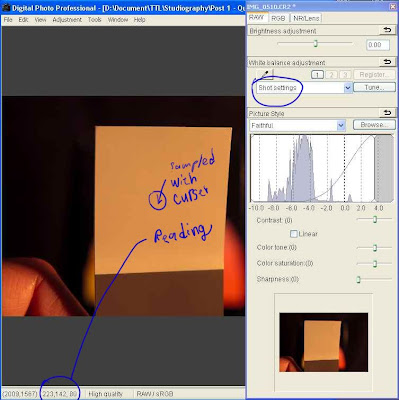 So let's take a look at how we can set the white balance manually using DPP. In this first image we are looking at the shot of the white balance card from earlier in this series. The light source was tungsten, so the appearance is heavily biased toward red (the color temperature is very warm).
So let's take a look at how we can set the white balance manually using DPP. In this first image we are looking at the shot of the white balance card from earlier in this series. The light source was tungsten, so the appearance is heavily biased toward red (the color temperature is very warm).We begin the process of finding the white balance by first setting the adjustment mode (circled at the upper right of the image) to “Color Temperature” as shown in the next photo.
 Next, we move the temperature slider until the white patch appears close to white. Measurements are taken by simply moving the cursor over the white patch. Note that the measurements will vary a little from spot to spot, but one quickly gets an idea of just how close to a neutral white the color is getting. Remember that neutral will be when all three of the RGB values are identical (or in this case, close).
Next, we move the temperature slider until the white patch appears close to white. Measurements are taken by simply moving the cursor over the white patch. Note that the measurements will vary a little from spot to spot, but one quickly gets an idea of just how close to a neutral white the color is getting. Remember that neutral will be when all three of the RGB values are identical (or in this case, close).
I was able to get a reading of 157, 148, 149 by only adjusting the color temperature slider. This is not bad at all, but why stop there when we can shoot for something better? With DPP we can fine tune the color by pressing the “Tune” button.
 The “White balance fine adjustment” window pops open and in it we can see a color wheel that covers the rainbow around its perimeter, with a graduated fading to white toward the center. In the center is a a small movable marker. Moving the marker toward any color will add that color to the image. The closer it is moved toward the perimeter, then the more of that color gets added. Note that the colors for opposing sides of the color wheel are opposite colors. This gives you a visualization of what is happening with your image as you move the marker. Moving it toward red, adds red and subtracts cyan. Moving it toward blue, adds blue and subtracts yellow, and so on.
The “White balance fine adjustment” window pops open and in it we can see a color wheel that covers the rainbow around its perimeter, with a graduated fading to white toward the center. In the center is a a small movable marker. Moving the marker toward any color will add that color to the image. The closer it is moved toward the perimeter, then the more of that color gets added. Note that the colors for opposing sides of the color wheel are opposite colors. This gives you a visualization of what is happening with your image as you move the marker. Moving it toward red, adds red and subtracts cyan. Moving it toward blue, adds blue and subtracts yellow, and so on.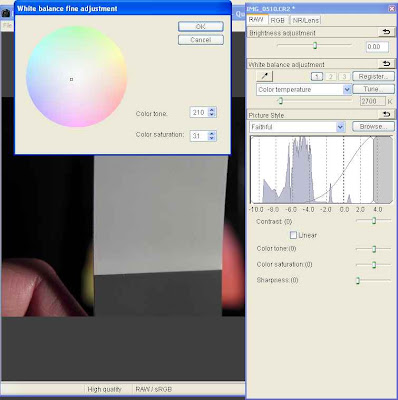 Since the RGB reading of 157, 148, 149 indicates a bit too much red, I moved the marker just a little towards cyan. Unfortunately, Canon did not think to provide a way to measure the effect on the image while the White balance fine adjustment window is open, so to test the impact of the adjustment, this window must be closed so a measurement can be made. Clicking “OK” will close the window without loosing the adjustment setting.
Since the RGB reading of 157, 148, 149 indicates a bit too much red, I moved the marker just a little towards cyan. Unfortunately, Canon did not think to provide a way to measure the effect on the image while the White balance fine adjustment window is open, so to test the impact of the adjustment, this window must be closed so a measurement can be made. Clicking “OK” will close the window without loosing the adjustment setting.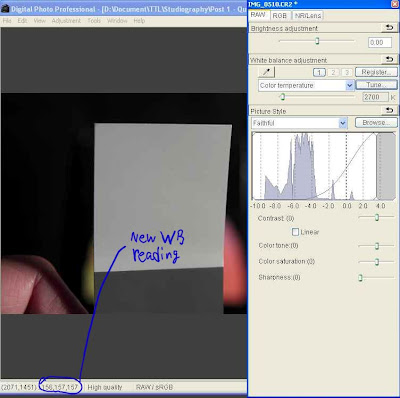 I performed a series of adjustments by opening and closing the White balance fine adjustment window until getting the near perfect white balance seen in the next image. The reading of (155, 156, 157) is very good, so I leave it at that.
I performed a series of adjustments by opening and closing the White balance fine adjustment window until getting the near perfect white balance seen in the next image. The reading of (155, 156, 157) is very good, so I leave it at that. One of the advantages of using raw files is that you can set the white balance for all files shot under the same lighting. To make this easy, Canon have supplied a way to save the image settings (which Canon calls a “recipe”) into a file. Select the Edit menu and then Save recipe in file... as shown. You can give the recipe any name you like.
One of the advantages of using raw files is that you can set the white balance for all files shot under the same lighting. To make this easy, Canon have supplied a way to save the image settings (which Canon calls a “recipe”) into a file. Select the Edit menu and then Save recipe in file... as shown. You can give the recipe any name you like. Since I have a photo that was taken under the same lighting as the white patch, I want to apply my saved recipe to it. I open the photo in DPP and then to make use of the recipe, select the Edit menu and then Read and paste recipe from file...
Since I have a photo that was taken under the same lighting as the white patch, I want to apply my saved recipe to it. I open the photo in DPP and then to make use of the recipe, select the Edit menu and then Read and paste recipe from file...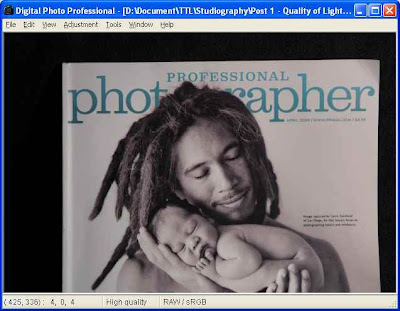 The file has inherited the saved settings and the result is a perfectly white balanced image.
The file has inherited the saved settings and the result is a perfectly white balanced image.If there are several for which you want to apply the same recipe, this can be done from DPP's main window without opening a raw file. Simply select the images (holding down the control key lets you select multiple individual images) and then access the Edit menu and then Read and paste recipe from file... and select the previously saved file. All of the selected files will inherit the saved settings.
Coming Next
I can see that this post is getting kind of lengthy, so I'm going to break it apart. Next time I will cover manual white balance using Bibble Pro. Until then...
-Gene
Continue on to Temperature of Light - part 9 (Manual White Balance with Raw Files using Bibble 4.10 Pro)
Saturday, June 6, 2009
Temperature of Light - part 7 (Custom White Balance with Raw Files)
Welcome to another installment of Studiography! It has been a few days since you last heard from me, sorry for the delay. This was supposed to be the last installment for the series on the
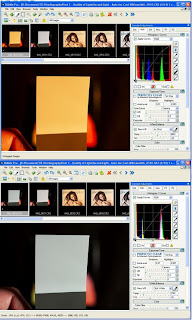 temperature of light, and I think it is about time to wrap things up, but after writing the material for this post on using the automatic method for obtaining a custom white balance, I realized that I also need to discuss the manual white balance controls, so I will finish up with one final post after this. If you are new to the blog, please feel free to peruse the earlier postings. I suggest going back to the beginning of the series on “Light: In the Beginning” and read forward from there. The first post is a bit dry, but they do get better after that :-) All of the archived postings contain a link to the next post, so you can easily read them in sequence.
temperature of light, and I think it is about time to wrap things up, but after writing the material for this post on using the automatic method for obtaining a custom white balance, I realized that I also need to discuss the manual white balance controls, so I will finish up with one final post after this. If you are new to the blog, please feel free to peruse the earlier postings. I suggest going back to the beginning of the series on “Light: In the Beginning” and read forward from there. The first post is a bit dry, but they do get better after that :-) All of the archived postings contain a link to the next post, so you can easily read them in sequence. Raw Files (background info)
This post involves working with raw files, but at this time we will only be looking at white balance. For anyone unfamiliar with the term raw file, it is a file composed of data read directly from the camera's sensor. Most digital cameras use a monochromatic sensor, so in order to create RGB (Red, Green, Blue) color channels, the sensor is fitted with a color filter array composed of red, green and blue filters arranged in a symmetric pattern with one filter element for each photo site on the sensor. A program called a raw converter is used to interpolate a color and intensity for each photo site by using readings from surrounding pixels to create a jpeg or tiff file.
A study of the color filter array will yield a better understanding of what a raw file contains. There are several good articles already written on this subject and it is far beyond the scope of this posting, so rather than replicate what already exists in abundance, here are some links to follow for more information. DPReview, Wikipedia, Harvard, and John Savord's excellent writeup. An Internet search will produce a proliferation of similar reports.
All DSLR cameras and many digicams can output raw files either along side or in place of jpeg files. These files contain all 100% of the data from the sensor with no loss from compression or any other processing. In order to make use of these files, they must be processed by a raw converter. The camera manufacturer usually includes raw converter software as part of the package, but many people prefer the performance and/or features found in third party software, such as Adobe Lightroom, Adobe Camera Raw, Bibble, Capture One, et al.
For a number of years there has been a debate about the benefits of raw -Vs- jpeg files from the camera. At the end of the day one ends up with a jpeg file either way. However, the proponents of raw say that raw offers much more flexibility for processing, especially for white balance options. The jpeg shooters argue that in-camera jpegs are high quality and with features like picture styles, eliminate the need for shooting raw. In addition, in-camera jpeg files save a lot of processing time. For the record, I have been shooting raw for years and from my experiences, am thoroughly convinced that raw is the better work flow for me. That is all I'm going to say on the subject for now.
Custom White Balance (Intro)
So, let's get down to business. Virtually all raw converters offer a custom white balance tool. For the most part, all you need to do is select the white balance tool (eyedropper) and click on something that has neutral color content for a reference. This reference can be gray or near white, but cannot be black or pure white (0,0,0 or 255, 255, 255). For the examples in this posting, I am using the white patch from a QP Card.
You will need one image of the reference and will need the exposure to be reasonably close to correct and certainly not overexposed. If you have too hot of an exposure and the white reference has one or more blown color channels, the software cannot accurately determine its color. Once you click the tool on the neutral reference, the software will establish the white balance and you are done. It is very much like setting a custom white balance in the camera. For every shot taken under the same light source, you can use the same white balance settings or simply copy the white balance to those photos. This is one of the powerful features available to the raw shooter.
Custom White Balance Using Adobe Camera Raw (ACR) As you can see from the image above, the light source is very warm and the camera's setting is not even close to correct. To set the white balance, simply click on the White Balance tool at the upper left, then click the eyedropper anywhere on the white patch.
As you can see from the image above, the light source is very warm and the camera's setting is not even close to correct. To set the white balance, simply click on the White Balance tool at the upper left, then click the eyedropper anywhere on the white patch.
 After balancing, you can see that the white patch is now a good representation of white. I took a color reading in the center of the patch. ACR is showing RGB values (1) of (154, 153, 151), which is very good. The “White Balance” control (2) now shows “Custom” and the “Temperature” display (3) is at 2600 degrees K. ACR does not show the tint on this screen.
After balancing, you can see that the white patch is now a good representation of white. I took a color reading in the center of the patch. ACR is showing RGB values (1) of (154, 153, 151), which is very good. The “White Balance” control (2) now shows “Custom” and the “Temperature” display (3) is at 2600 degrees K. ACR does not show the tint on this screen.
Custom White Balance Using Bibble 4.10 To set the white balance, simply click on the White Balance tool at the right, then click the eyedropper anywhere on the white patch.
To set the white balance, simply click on the White Balance tool at the right, then click the eyedropper anywhere on the white patch.
 After balancing, you can see that the white patch is now a good representation of white. I took a color reading in the center of the patch. Bibble is showing RGB values (1) of (185, 193, 188), which is good. The “White Balance” control (2) now shows “Click White”, the “Temp” display (3) is at 2762 degrees K, and the “Tint” control is at -34, which adds a little bit of green.
After balancing, you can see that the white patch is now a good representation of white. I took a color reading in the center of the patch. Bibble is showing RGB values (1) of (185, 193, 188), which is good. The “White Balance” control (2) now shows “Click White”, the “Temp” display (3) is at 2762 degrees K, and the “Tint” control is at -34, which adds a little bit of green.
Custom White Balance Using Canon Digital Photo Professional (DPP) To set the white balance, simply click on the White Balance tool at the right, then click the eyedropper anywhere on the white patch.
To set the white balance, simply click on the White Balance tool at the right, then click the eyedropper anywhere on the white patch. After balancing, you can see that the white patch is now a good representation of white. I took a color reading in the center of the patch. DPP is showing RGB values (1) of (147, 152, 156), which is acceptable. The “White Balance” control (2) now shows “Click White Balance”. Oddly, there is no temperature display for DPP.
After balancing, you can see that the white patch is now a good representation of white. I took a color reading in the center of the patch. DPP is showing RGB values (1) of (147, 152, 156), which is acceptable. The “White Balance” control (2) now shows “Click White Balance”. Oddly, there is no temperature display for DPP.
Coming Next
It is now past my bed time, so I'm saving the part on manual white balance for next time. Until then...
-Gene
Continue on to Temperature of Light - part 8 (Manual White Balance with Raw Files using Canon's DPP)

